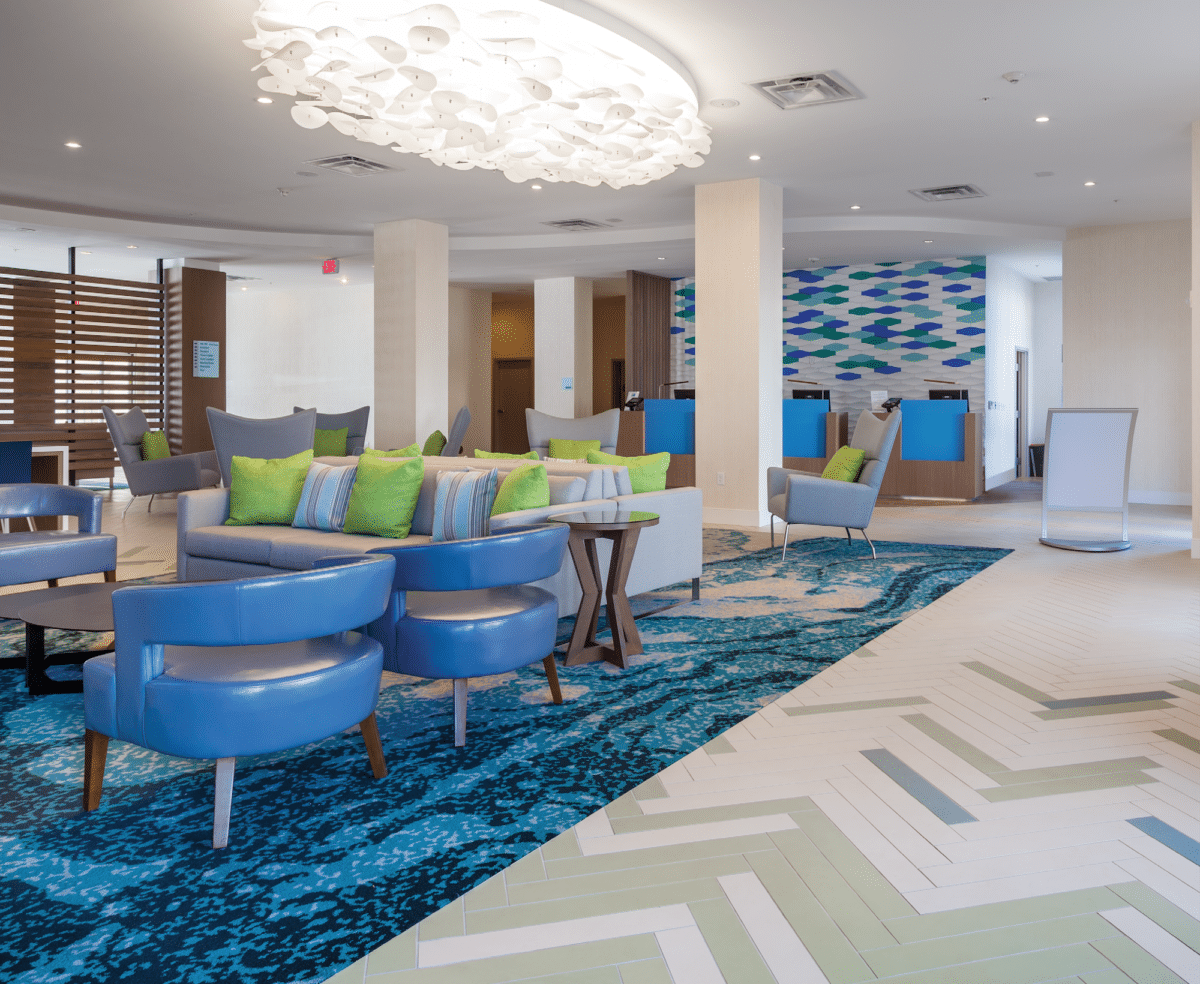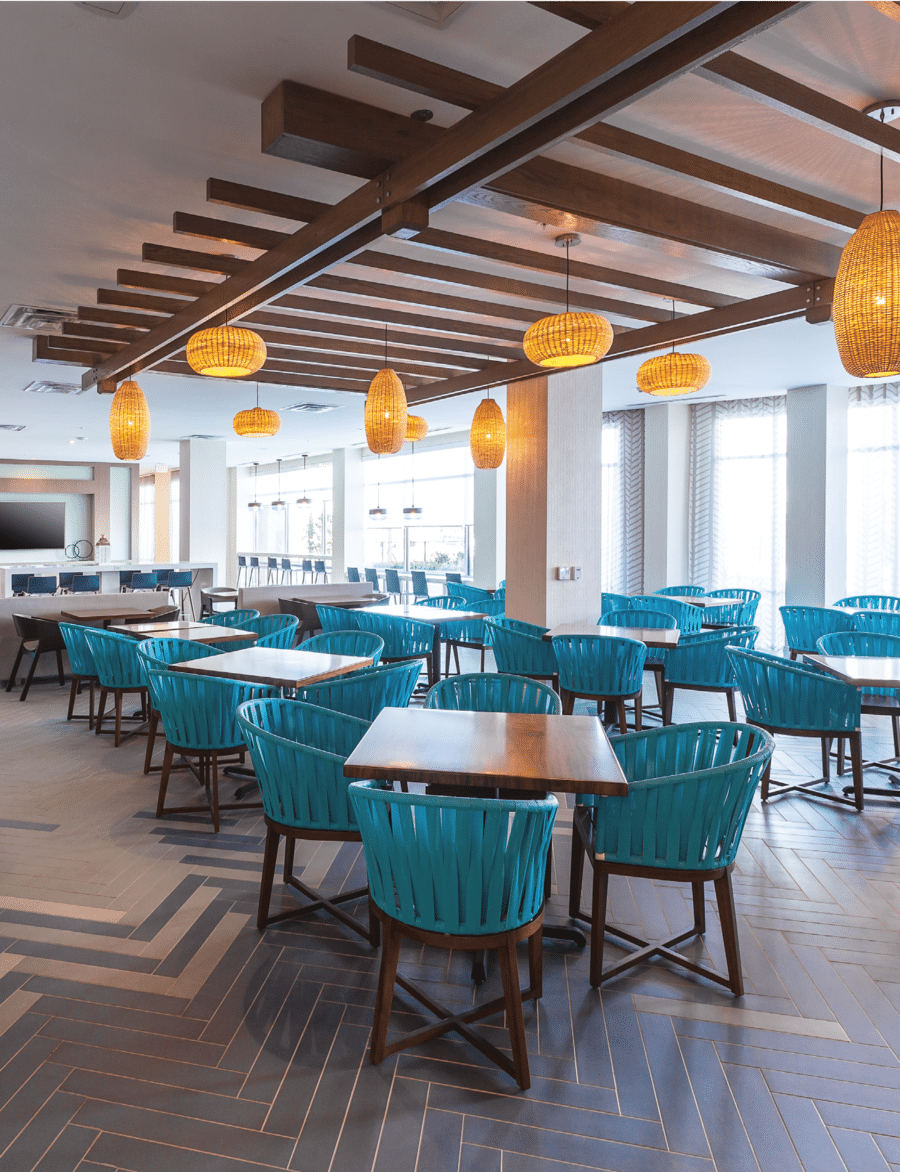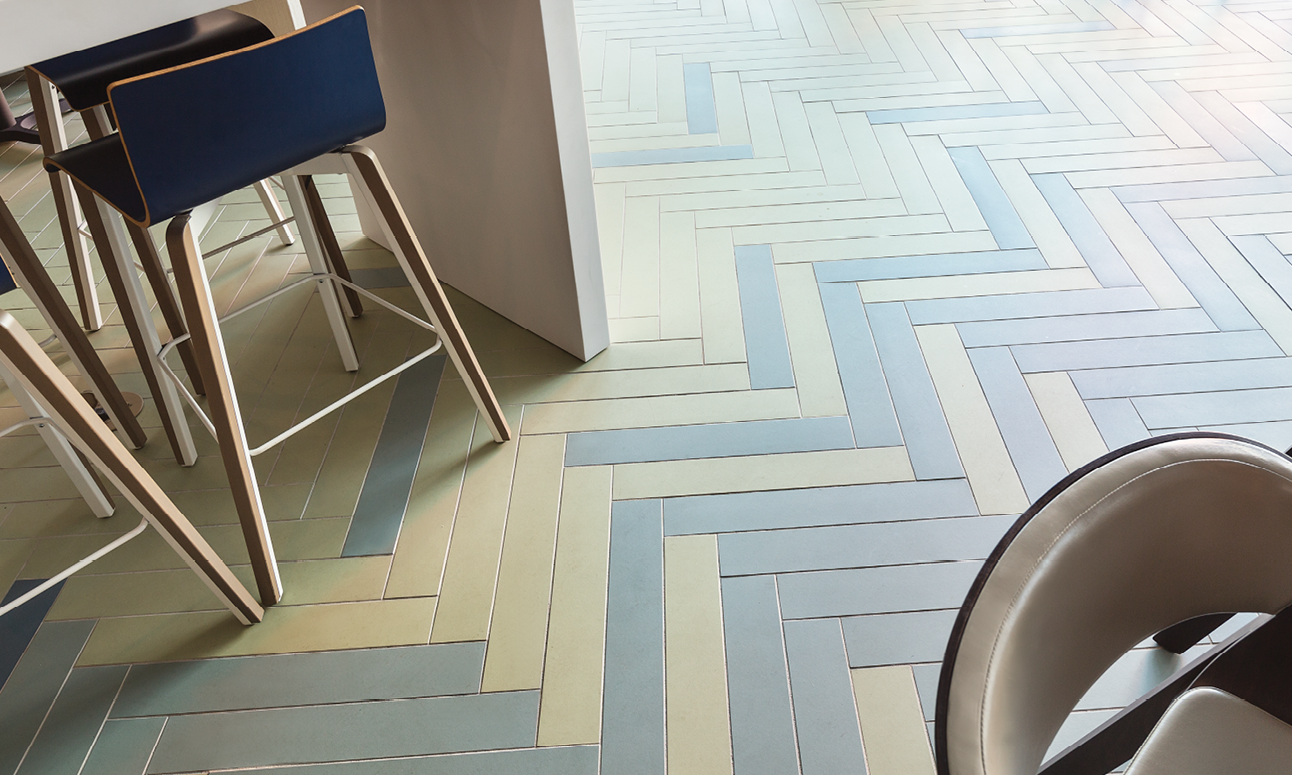
The Holiday Inn Express & Suites Orlando at SeaWorld features DSA’s Hydrophilic Tile technology. [Photo: Scott Watt Photography]
Deutsche Steinzeug America is transforming spaces with hydrophilic tile while reducing indoor pollutants.
Choosing tile for the lobby of the Holiday Inn Express & Suites Orlando at SeaWorld—which opened in October 2017—was a no-brainer for the developer Mandala Holdings.
The designers wanted to create the feeling of walking into the ocean, with a herringbone pattern of teal and deep blue tile gradually getting darker as guests move into the hotel. “We wanted to create something guests could take home as an emotional and mental souvenir,” says Vinay Rama, founder and CEO of Mandala Holdings. The color palette and tile sizes that German-based company Deutsche Steinzeug America, Inc.—known as DSA in the U.S.—offered made their vision a reality and so much more.
Beyond its distinct aesthetics, DSA tile has a feature unique to its brand—“HT,” or Hydrophilic Tile technology. A refinement of titanium dioxide, a photocatalytic oxidizer, is applied during the glazing process and then fired into the tiles—making it a permanent part of the product for a host of benefits that will last the lifetime of the tile. The tiles have an antimicrobial effect, killing bacteria like E.coli and MRSA on contact. They can also be slip-resistant, are easy to clean, odor eliminating, and non-marking. You’ll currently find them in the Brooklyn-Battery Tunnel in New York City because of their anti-graffiti properties.
FROM OUR JANUARY+FEBRUARY 2018 ISSUE
The preferred publication of leading green professionals.

[Photo: Courtesy of Scott Watt Photography]
A Safe and Clean Alternative
The application of titanium dioxide on the tiles causes a chemical reaction when charged by light, says Heather Walker, distributor and A&D sales manager-US for DSA. The activated oxygen breaks down the cell walls of bacteria. When bacteria comes in contact with the tile it’s rendered inactive, Walker says, thus eliminating germs and viruses and clearing the air of unwanted odor compounds—including NOx gases.
The tile’s hydrophilic property causes water to spread out in a film, rather than bead. The hydrophilic property lifts dirt and debris away from the tile, speeding up cleaning time and chemical consumption by more than 50%, Walker says.
Unlike carpet and hardwood floors, which sometimes harbor harmful chemicals known as volatile organic compounds (VOCs), DSA tile is virtually chemical-free. Titanium dioxide is a nontoxic, naturally occurring substance commonly found in deodorants, toothpaste, makeup, food, and medications. Walker says it’s safe to animals, humans, and plant life and never produces harmful vapors or fumes.
“We feel it’s a technology that can do a lot of good,” she says. “For example, in health care, there are a ton of people who go into a facility to get well but end up getting sicker while there.” Using a tile with HT Coating reduces the spread of germs, and the tiles are catching on for use in a variety of environments, from health care facilities to schools and in residential areas. “Our goal is to cover every surface of the world,” Walker says.
Tile also keeps dirt, dust, pollen, and other allergens at bay, as they’re easily wiped away, further improving indoor air quality.

[Photo: Scott Watt Photography]
Endless Options
“Designing with tile is limitless,” says Andrew Brown, president of Traditions in Tile and Stone—the DSA distributor who worked on the Holiday Inn project. Brown regularly works with clients who enter his showroom with a specific design in mind and the uncertainty that it will be achievable, then he pulls out the color wheel from DSA. “(The client) says, ‘Oh my goodness. You can do this.’ It is an incredible offering.”
DSA regularly works with designers to create patterns and color blends specific to their vision. “As a company, we do a lot that is not typical,” says Mark Ficarra, national sales director for DSA.
The artistic variety DSA offers is originally what caught the eye of Holiday Inn’s designers, but the added benefits are what sold them. The HT Coating was fitting for a hotel environment—especially a breakfast area where there is a high risk of spillage, says Lee Babcock, CIO for Mandala Holdings. “It’s an example of how green manufacturers are pushing the envelope on traditional building materials. They’re making them green and also making them better. It’s like being rewarded for doing the right thing.”
A Long-Term Choice
Of course, tile has a number of benefits. The high temperatures that ceramic is fired at makes it fire resistant. Unlike carpet, which has to be replaced over time and cleaned regularly, tile is durable and easy to clean. It also has benefits over natural stone, which can require more maintenance and have special cleaning requirements, Ficarra says.
When installed properly, tile should only require routine grout maintenance, which Walker says is getting easier because of ongoing setting material improvements. “It’s a life cycle product. If installed properly, tile can remain in the building for the life of that building,” Ficarra says.
Its durability and longevity also make it a more economical choice—another reason it was a top choice for Holiday Inn. “Our perspective was to be smart about the materials we use. Tile is durable and a great way to reduce the operating and lifecycle costs of a hotel,” Babcock says.

[Photo: Courtesy of Scott Watt Photography]
HOW IT WORKS
PHOTOCATALYTIC OXIDATION
The titanium dioxide coating—a form of nanotechnology—used in DSA tiles works as an antimicrobial agent because of its photocatalytic oxidizing properties. Photocatalytic oxidation occurs when the titanium dioxide interacts with light or water to activate the movement of electrons.
Photocatalytic oxidation deactivates cells by attacking the cell walls and converting them into carbon dioxide and water. Once the wall is compromised, the interior of the cell leaks out and the cell becomes inactive.
The process results in the surface becoming superhydrophilic—rather than beading on the surface, the water spreads out in a thin sheet. As the water flows, dirt and debris are lifted from the tile, making the tile easier to clean.
Common Disinfection Methods vs. Photocatalytic Oxidation Methods
COMMON METHODS
- Use toxic chemicals
- Can lead to re-growth of harmful microbes
- Byproducts can be toxic to humans
PHOTOCATALYTIC OXIDATION METHODS
- No toxic chemicals used
- Deactivate microbes to prevent re-growth
- Non-toxic byproducts
- No production of vapors of fumes
- Creates healthy living environment
Learn more about DSA and see more gb&d flooring stories.

